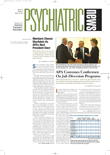When persons with posttraumatic stress disorder remember trauma, right areas of their brains tend to be activated, whereas when individuals without PTSD remember trauma, left areas of their brains are apt to be aroused, according to a study reported in the January American Journal of Psychiatry.
The study was headed by Ruth Lanius, M.D., Ph.D., an assistant professor of psychiatry at the University of Western Ontario in London, Ontario, and an affiliate of the Robarts Research Institute.
Lanius and her colleagues studied 11 persons who had developed PTSD as a result of sexual abuse/assault or of a motor vehicle accident, and 13 persons who had experienced sexual abuse/assault or a motor vehicle accident but did not develop PTSD as a result. All subjects were right-handed and of similar age, gender, and race.
Each of these subjects was instructed to recall the traumatic event that he or she had experienced. While the subjects were recollecting, the scientists determined which areas of their brains were activated using functional magnetic resonance imaging and functional connectivity analyses. These permit assessment of the activity of a network of neurons across more than one area of the brain.
The investigators found notable differences between the two groups when they compared the results. For example, subjects with PTSD showed more activation in certain right-brain areas—the right posterior cingulate gyrus, the right caudate, the right parietal lobe, and the right occipital lobe. Subjects without PTSD showed more activation in certain left-brain areas—the left superior frontal gyrus, the left anterior cingulated gyrus, the left caudate, the left parietal lobe, and the left insula.
Lanius and her team suspect that this contrasting pattern of brain activation may help explain why PTSD patients tend to experience traumatic recall as flashbacks (spontaneous, vivid, usually visual memories unchanging over time) and why non-PTSD individuals are more apt to experience traumatic memories as verbal narratives.
For example, the right parietal lobe is known to be involved in the nonverbal memory retrieval of events in people’s lives, so its activation while persons with PTSD are remembering distressing events may very well help explain why they recall these events as flashbacks. In contrast, the left brain areas activated by non-PTSD individuals when they recollect disturbing events are consistent with verbal episodic memory retrieval and may help explain why they remember such events as verbal narratives.
“This is a fantastically interesting study,” Bessel van der Kolk, M.D., a professor of psychiatry at Boston University and medical director of the Trauma Center there, said in an interview. “Dr. Lanius has elegantly demonstrated how people’s brain function differs when they are in dissociate states. . . . We always suspected that when people go into these states, there is a decrease in activation of the left inferior prefrontal cortex—meaning that people are less capable of taking in new information and being curious about the world out there—and that the brain shifts to a more right posterior activation—more to a state of fear and flight.”
Dutch scientists have also just published findings very similar to those of Lanius and her colleagues, van der Kolk pointed out, which gives added legitimacy to the findings of Lanius and her team.
Van der Kolk said that he was pleased to see such studies being pursued by Canadian and European scientists.
The study was financed by the Canadian Institutes of Health Research and the Ontario Mental Health Foundation.
Am J Psychiatry 2004 161 36
